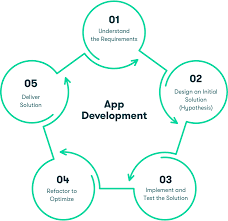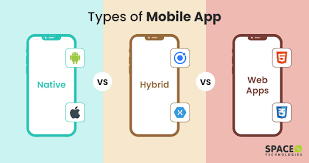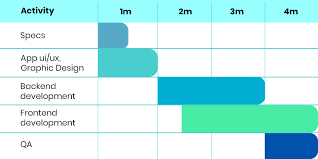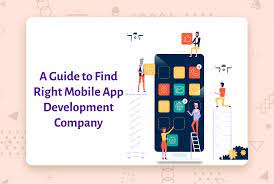Mobile app development in the United State is a dynamic field that offers immense potential . This guide provides a comprehensive overview of the mobile app development process, focusing on the US market.
Market Research:
Start by researching your target audience and analyzing competitors to refine your app idea.
Defining Purpose and Features:
Clearly define your app’s purpose and core features to lay a strong foundation.
Platform Selection:
Decide whether to develop for iOS, Android, or both based on audience preferences and available resources.
Wireframing and Design:
Create user-friendly wireframes and visually appealing mockups that align with your app’s purpose.
Development:
Write efficient code using suitable programming languages and frameworks.
Testing and QA:
Thoroughly test your app on various devices to identify and fix bugs and gather user feedback.
Security and Privacy:
Implement robust security measures to protect user data and comply with privacy regulations.
Monetization Strategy:
Choose an appropriate monetization strategy, such as ads, in-app purchases, or subscriptions.
App Store Submission:
Follow guidelines to prepare and submit your app to app stores.
Marketing and Promotion:
Develop a marketing plan using social media, email, and app store optimization (ASO).
User Feedback and Updates:
Continuously gather feedback and release updates to improve user experience.
Legal Compliance:
Stay informed about and comply with US and international laws.
Mobile app development in the United State offers tremendous opportunities. By following this guide, you can increase your chances of creating a successful app.
Key Stages Of The App Development Process

The app development process comprises several key stages that form the foundation for creating a successful application.
Idea Generation :
The process begins with brainstorming and idea generation. Identify a problem or need in the market that your app can address effectively. Ensure that your idea is unique and has potential.
Market Research :
Thoroughly research your target audience, competitors, and current market trends. Understanding user preferences and market demands is essential to refine your app concept.
Planning and Strategy :
Develop a comprehensive project plan and strategy that outlines the app’s features, functionalities, and a timeline for development. Allocate resources and set clear objectives.
Design :
Create wireframes and design mockups to visualize the app’s user interface and user experience (UI/UX). Design should focus on usability, aesthetics, and user engagement.
Development :
This stage involves writing code, building the app’s architecture, and integrating features. Developers follow the plan and coding standards, ensuring the app’s functionality and performance.
Testing and Quality Assurance (QA) :
Rigorously test the app to identify and resolve bugs, glitches, and usability issues. QA ensures a seamless user experience.
Deployment :
Prepare the app for launch by optimizing performance, setting up servers, and configuring databases. Deploy the app to the respective app stores (e.g., Apple App Store, Google Play Store).
Marketing and Promotion :
Develop a marketing strategy to create awareness about the app. Utilize various channels, including social media, email marketing, and app store optimization (ASO).
User Feedback and Updates :
Continuously gather user feedback to make improvements and release regular updates. Listening to user suggestions enhances the app’s long-term success.
Maintenance and Support :
Provide ongoing maintenance, address user issues, and keep the app up to date with OS updates and new features.
These stages ensure a structured and successful app development process. It is essential to avoid plagiarism when using external sources for research or reference in any part of this process.
The undeniable prevalence of mobile app usage makes a compelling argument for businesses to invest in developing their mobile apps.

The increasing prevalence of mobile app development in the United State usage underscores the compelling business case for developing a mobile app. With billions of smartphones in use worldwide, mobile apps have become integral tools for businesses to connect with their audience and drive growth.
Firstly, mobile apps provide a direct and convenient channel for customer engagement. Users spend a significant portion of their online time on mobile devices, making apps a prime platform for businesses to reach and interact with their target demographics.
Secondly, mobile apps enhance customer loyalty and retention. Through personalized experiences, push notifications and seamless transactions, businesses can create lasting relationships with their users, increasing the likelihood of repeat business.
Moreover, mobile apps offer valuable data insights. They allow businesses to gather user behaviour and preference data, enabling informed decision-making and targeted marketing strategies.
Additionally, mobile apps can boost sales and revenue streams. E-commerce apps, for example, facilitate effortless shopping experiences, while apps with subscription models generate recurring income.
Lastly, mobile apps can streamline internal operations, improving efficiency and productivity. From employee communication to inventory management, businesses can optimize their processes.
In conclusion, the widespread adoption of mobile apps by consumers underscores their immense potential as powerful business tools. By harnessing the advantages of mobile app usage, companies can enhance customer engagement, increase revenue, and gain a competitive edge in today’s digital landscape.
Varieties of Mobile Applications

Mobile applications, commonly known as mobile apps, come in various forms, catering to diverse user needs and preferences.
Native Apps :
Native apps are specifically designed for a particular mobile platform, such as iOS or Android. They offer optimal performance and take full advantage of the platform’s features, making them highly responsive and efficient.
Web Apps :
Web apps are accessible through a web browser on a mobile device. They do not require installation and are platform-independent. Web apps are versatile and easy to update but may have limited access to device features.
Hybrid Apps :
Hybrid apps combine elements of both native and web apps. They are built using web technologies like HTML, CSS, and JavaScript but run within a native container. This approach allows developers to write code once and deploy it across multiple platforms.
Progressive Web Apps (PWAs) :
PWAs are web apps designed to provide a native app-like experience on the web. They offer features such as offline access, push notifications, and smooth performance. PWAs are accessible through web browsers but can be added to the home screen for quick access.
Cross-Platform Apps :
Cross-platform apps are developed using frameworks like React Native, Flutter, or Xamarin. They enable developers to create apps that work on multiple platforms, reducing development time and costs.
Augmented Reality (AR) Apps :
AR apps overlay digital information, such as 3D models or data, onto the real world through a device’s camera. These apps are used for gaming, education, and various industries like healthcare and retail.
Virtual Reality (VR) Apps :
VR apps immerse users in a computer-generated environment, often requiring VR headsets. They are popular in gaming, simulation, and training applications.
IoT Apps :
Internet of Things (IoT) apps enable users to control and monitor connected devices and appliances remotely. They play a crucial role in home automation, smart cities, and industrial settings.
Enterprise Apps :
Enterprise apps are designed for businesses to streamline internal processes, improve productivity, and enhance communication among employees. They include project management, CRM, and collaboration tools.
Social Media Apps :
These apps connect users for social interaction, content sharing, and networking. Examples include Facebook, Instagram, and Twitter.
In conclusion, the diverse landscape of mobile applications reflects the ever-evolving technological ecosystem. Businesses and developers choose from these various types of apps based on their goals, target audiences, and the specific functionality they seek to deliver.
What Is the Typical Timeframe for Mobile App Development?

The timeframe for mobile app development in the United State can vary significantly based on several factors, including the complexity of the app, the platform(s) it’s designed for, and the development approach chosen. However, it’s possible to provide a general overview of the typical timeframe for various stages of app development:
Planning and Strategy (2-4 weeks) :
This initial phase involves defining the app’s concept, objectives, and target audience. Creating a detailed project plan and outlining the features and functionalities are crucial steps.
Design (4-8 weeks) :
The design phase includes wireframing, creating mockups, and developing the user interface (UI) and user experience (UX) design. It’s essential to focus on creating an intuitive and visually appealing design during this stage.
Development (8-24 weeks) :
The development timeframe depends on the app’s complexity and features. Native apps may take longer to develop compared to hybrid or cross-platform apps. Coding, testing, and integration of features are integral parts of this stage.
Testing and Quality Assurance (4-8 weeks) :
Rigorous testing is critical to ensure the app functions correctly, is bug-free, and offers a seamless user experience. Both manual and automated testing are typically employed.
Deployment (2-4 weeks) :
Preparing the app for launch involves optimization, server setup, and final testing before submitting it to the app stores.
Post-Launch and Updates (ongoing) :
After the app is live, ongoing maintenance, user support, and regular updates based on user feedback and market changes are essential.
In summary, the typical timeframe for mobile app development ranges from 6 months to a year for a moderately complex app. Simpler apps with fewer features may take less time, while highly complex apps with advanced functionalities can take more than a year. It’s crucial to keep in mind that this timeline is an estimate, and actual development times may vary.
Exploring User Interface (UI) and User Experience (UX) Design in Mobile App Development

Delving into User Interface (UI) and User Experience (UX) Design is integral to the success of any mobile app developmentin the United State project. These two aspects are the cornerstones of creating an engaging and functional mobile application that resonates with users.
User Interface (UI) Design :
UI design focuses on the visual elements of the app, encompassing layout, colours, typography, and interactive elements. It aims to create an aesthetically pleasing and intuitive interface that guides users seamlessly through the app’s functionalities. UI designers prioritize consistency and clarity in design to enhance user comprehension and navigation. They ensure that buttons, icons, and menus are well-placed and visually appealing, creating a visually cohesive and pleasant user experience.
User Experience (UX) Design :
UX design goes beyond aesthetics, concentrating on the overall user journey within the app. UX designers aim to provide a satisfying and meaningful interaction for users. They consider user needs, preferences, and pain points, conducting user research and usability testing to refine the app’s functionality. UX design involves creating wireframes and prototypes to plan user flows, making sure that the app is intuitive, efficient, and user-centric.
In conclusion, the harmonious integration of UI and UX design is crucial in mobile app development. A well-crafted UI enhances the visual appeal, while UX design ensures that users have a seamless, enjoyable, and productive experience while using the app. This results in increased user engagement, satisfaction, and ultimately, the success of the mobile application.
Selecting the Optimal Mobile App Development Platform for Your Business

When embarking on the journey of mobile app development in the United State for your business, choosing the right platform is a pivotal decision. It can significantly impact your app’s reach, performance, and development process. Here, we explore the essential factors to consider when selecting the optimal mobile app development platform.
Target Audience :
Understand your target audience’s preferences. Determine whether your users primarily use iOS, Android, or both platforms. This knowledge will guide your platform choice.
Budget and Resources :
Consider your budget and the resources available for app development. Developing for both iOS and Android simultaneously may require a larger investment, while cross-platform or hybrid solutions can be more cost-effective.
Development Speed :
If speed is crucial, cross-platform development frameworks like React Native or Flutter allow you to write code once and deploy it on multiple platforms, reducing development time.
Performance :
Native app development provides the best performance, as apps are optimized for their respective platforms. If your app requires complex features or high-performance graphics, native development is preferable.
App Maintenance :
Think about long-term app maintenance. Maintaining separate codebases for iOS and Android can be more time-consuming and costly than managing a single codebase with cross-platform development.
User Experience :
User experience is vital. Native apps often provide a smoother and more seamless experience due to platform-specific design and functionality.
In conclusion, choosing the right mobile app development platform is a strategic decision that depends on your business goals, target audience, budget, and development resources. It’s essential to weigh the pros and cons of each platform to make an informed choice that aligns with your business objectives.
FAQ’S
Certainly! Here’s a list of frequently asked questions (FAQ) about mobile app development in the United States:
1. What is mobile app development?
- Mobile app development is the process of creating software applications specifically designed to run on mobile devices, such as smartphones and tablets.
2. Why is mobile app development important for businesses in the US?
- Mobile apps offer businesses a direct and convenient channel to engage with their customers, increase brand visibility, and boost revenue through various monetization strategies.
3. What are the key stages of mobile app development?
- The key stages typically include ideation, market research, design, development, testing, deployment, marketing, and ongoing maintenance.
4. How long does it take to develop a mobile app in the US?
- The timeline for app development varies depending on complexity but usually ranges from several months to a year.
5. What are the different types of mobile apps available?
- Mobile apps come in various types, including native apps (iOS and Android), web apps, hybrid apps, progressive web apps (PWAs), and more.
- Effective marketing strategies include social media promotion, email marketing, influencer marketing, and paid advertising campaigns.

















